16 Unhealthiest Store-Bought Condiments
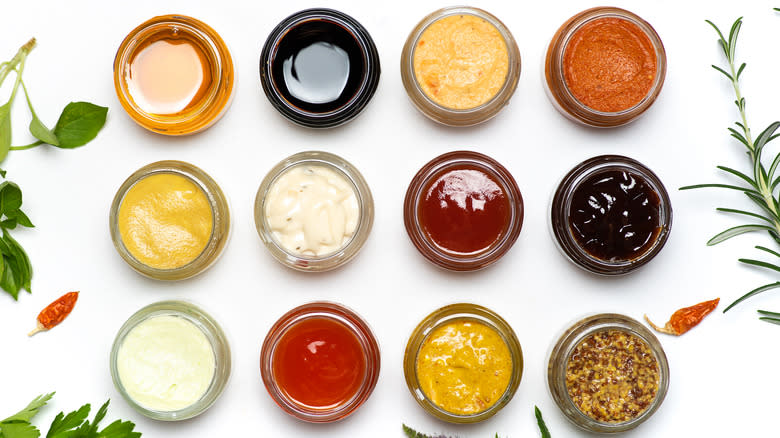
Condiments are pretty innocuous, right? You only add a little bit here and there; maybe you slather a spoonful of jam on your morning toast or carefully drizzle syrup onto your pancakes. Later in the day, you add a dollop of mayo to your hamburger bun at dinner -- can't forget the ketchup to go along with the fries -- no harm done.
However, condiments are one of the most overlooked foods, in terms of how they may be impacting your nutrition and health needs or goals. Condiments may seem simple and it probably feels like you're not eating all that much of them (unless you're drowning your dinner in ranch dressing). Unfortunately, condiments can hide a huge amount of sugar, fat, sodium, and/or processed ingredients that might not be all that great for your health. While making condiments at home can lessen these issues, not a lot of people are interested in regularly preparing everything from scratch, so they turn to the grocery store — and that's where they'll find these 16 unhealthiest store-bought condiments.
Read more: 12 Little-Known Facts About Salt
Ranch Dressing
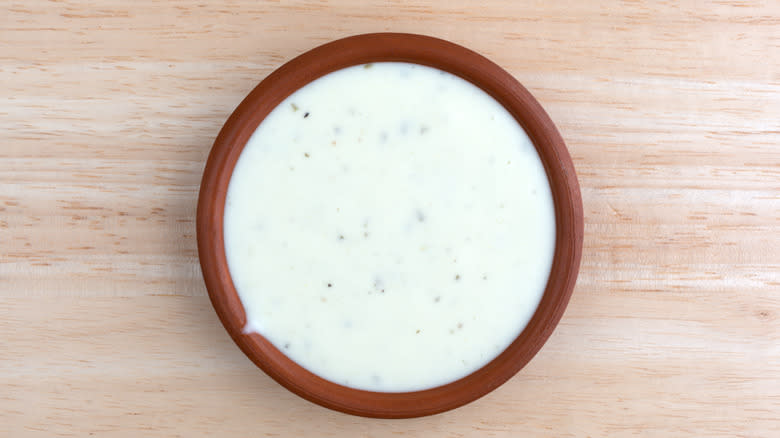
If you're trying to cut back on calories and have begun incorporating more salads into your diet, you probably know to reach for lighter, oil-based salad dressings over creamy ones. But is a little ranch dressing for your chicken strips or pizza such a bad thing? It depends on your health goals, but, overall, ranch dressing tends to pack on saturated fat, sodium, and preservatives.
The classic Hidden Valley Original Ranch comes with 13 grams of total fat in a 2-tablespoon serving, including 2 grams of saturated fat, 130 calories, and 260 milligrams of sodium. That means just a very small amount of dressing accounts for 17% of your recommended total fat intake for the day, 10% of your recommended saturated fat intake, and 11% of your recommended sodium intake. That's before you even consider what you're serving with the dressing. Kraft's buttermilk ranch dressing is slightly better in the fat department but slightly worse in the sodium department. For a healthier alternative, look for a yogurt-based ranch dressing or follow a simple homemade ranch dressing recipe.
Mayonnaise
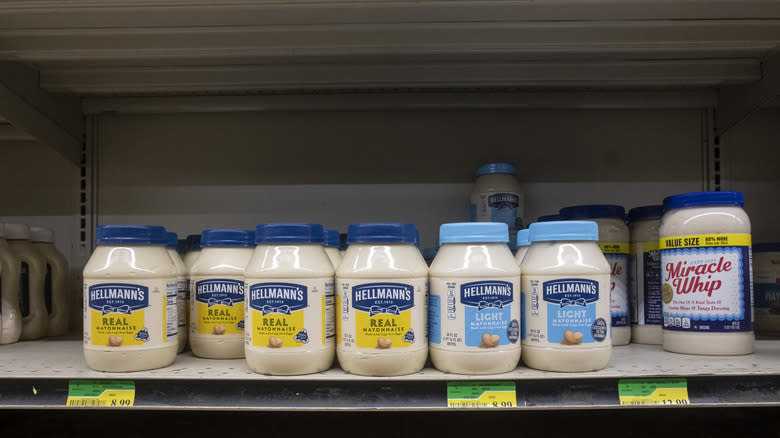
Mayonnaise is a divisive condiment. Some people absolutely hate it and some people absolutely love it. Those who love it often have a die-hard favorite brand, whether it be Hellmann's, Duke's, or another. These folks may have preferred ways to use their favorite mayo too, such as slathering it on sandwiches, using it as a dip, adding it to cake batter, or mixing it into scrambled eggs.
If you find yourself in the pro-mayo camp, just be careful how much you use. A 1-tablespoon serving of Kraft's mayo, for example, comes with 10 grams of fat, including 1.5 grams of saturated fat, per serving, which is 13% and 8% of your daily recommended intake, respectively. Hellmann's mayo is similar on the nutritional front. Additionally, many mayonnaise brands use soybean oil as their primary ingredient, which has been linked to numerous health problems, including obesity, diabetes, and neurological conditions (via ScienceDaily). For a healthier alternative, look for a mayonnaise made with a more nutritious oil, like olive or avocado.
Barbecue Sauce
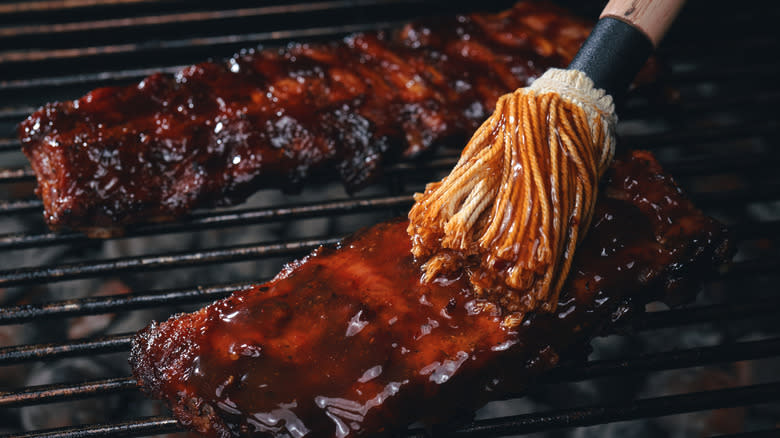
It is possible to buy barbecue sauces at the grocery store that are healthy in moderation. However, you'll want to take a close look at the nutrition labels before tossing a choice into your grocery cart. Often, barbecue sauces hide ample amounts of sugar, salt, or both, depending on your preferred variety. For example, French's Cattlemen's barbecue sauce comes with 460 milligrams of sodium in just 2 tablespoons, which is nearly 20% of your daily recommended intake.
Sweet Baby Ray's barbecue sauce contains less sodium (290 milligrams) but has 17 grams of sugar per 2-tablespoon serving, amounting to 32% of your daily recommended intake. To give you an idea of just how much sugar that is, a teaspoon of sugar is 4 grams of sugar; so eating a serving of Sweet Baby Ray's barbecue sauce is the equivalent of consuming more than 4 teaspoons of sugar.
For a healthier option, make homemade barbecue sauce (it's one of the easiest condiments to make from scratch) or look for sauces that rely on ingredients beyond sugar and salt for the flavor.
Sour Cream
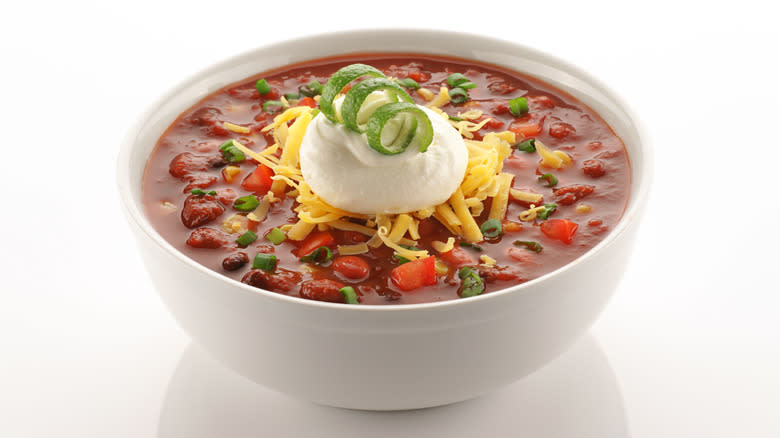
As an incredibly versatile ingredient, sour cream makes its way into cakes, soups, and on top of baked potatoes and potato skins. It seems pretty healthy — after all, isn't it closely related to yogurt? In reality, sour cream is a condiment best enjoyed in moderation. A 2-tablespoon serving contains 6 grams of fat (half of which is saturated) and 59 calories. So, while it's not as fat-filled as ranch dressing, it's still on the higher side for a condiment, especially if you like to add a hearty dollop.
Want a healthier alternative? Just look for reduced-fat sour cream, which contains nearly 40% less fat. Additionally, since sour cream is already pretty similar to Greek yogurt, consider swapping the two. You might also consider opting for sour cream with added health benefits, such as a fermented product that still contains natural probiotics, for an extra boost of gut health-enhancing properties.
Soy Sauce
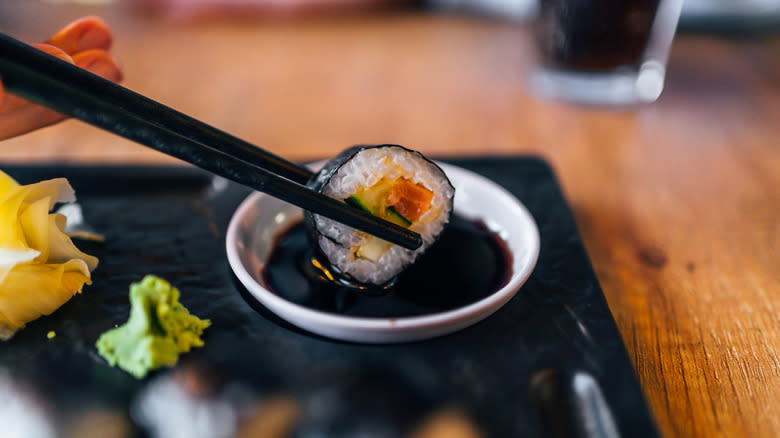
You can't have Chinese takeout or sushi without soy sauce. Fried rice without soy sauce? Who would even want it? As you can probably guess from soy sauce's very distinct flavor profile, it's filled with sodium. That's why it's so tasty and just a little goes a long way, but it's also why you can quickly increase your sodium levels for the day with just a splash of soy sauce on your dinner.
A 1-tablespoon serving of Kikkoman soy sauce contains 920 milligrams of sodium or nearly 40% of your recommended daily intake. The Amazon Fresh brand of soy sauce has even more, with 1,110 milligrams of sodium in a serving, almost half of your recommended daily intake. The U.S. Office of Disease Prevention and Health Promotion considers any product that contains more than 20% of your daily recommended intake of sodium in a serving to be "high sodium," and highlights that consuming too much sodium can lead to serious issues like heart attack or stroke. As such, you might want to look for a lower-sodium soy sauce at the grocery store, but even those can still fall into the government's "high sodium" category. Overall, if you're worried about your sodium consumption, this might be one condiment to skip entirely.
Ketchup
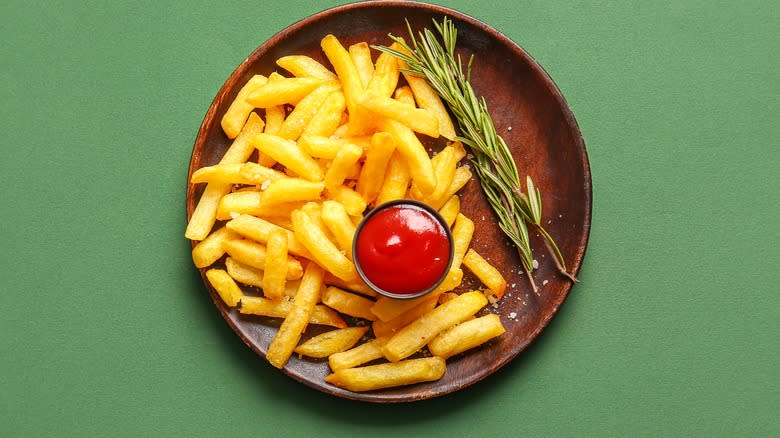
Ketchup may not taste particularly sweet, but it can be high in both sugar and sodium. For example, Whataburger's Fancy Ketchup contains 4 grams of sugar and 200 milligrams of sodium per serving (8% of your daily recommended value). Likewise, Heinz's ketchup includes a similar nutritional profile. Remember, a teaspoon of sugar is 4 grams of sugar, so each serving of ketchup you eat is equal to eating a teaspoon of straight sugar.
Additionally, ketchup often gets its added sugar content from high fructose corn syrup — an ingredient that Cleveland Clinic recommends not consuming at all, citing reasons such as increased risk of insulin resistance, obesity, diabetes, high blood pressure, non-alcoholic fatty liver disease, leaky gut, and more. Consider buying sugar-free versions or making your own ketchup at home, so you can still enjoy the health benefits of tomatoes without the less-than-stellar side effects of high fructose corn syrup.
Sweet Relish
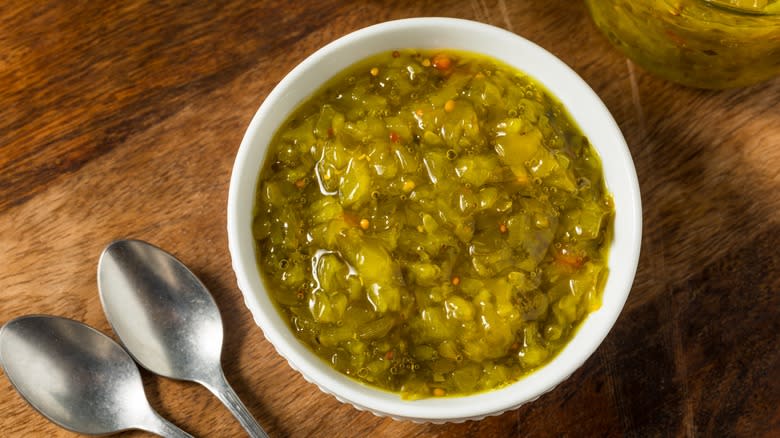
Relish is basically just finely chopped pickles with seasonings and flavorings added in, making it a delicious topping for hot dogs or just the right ingredient to give your potato salad a bit of crunch. However, while sweet relish can be healthy, some store-bought options contain a large amount of sodium and/or sugar, alongside less-than-desirable ingredients.
For example, Walmart's Great Value sweet relish contains 120 milligrams of sodium (5% of your daily recommended intake) and 4 grams of added sugar (8% of your daily recommended intake) per tablespoon. Additionally, the second ingredient right after cucumbers is corn syrup, followed by high fructose corn syrup, which health practitioners recommend avoiding. Likewise, Heinz's sweet relish contains 110 milligrams of sodium and 3 grams of added sugar per tablespoon, though it doesn't contain any high fructose corn syrup. It is possible to find sweet relish made with sugar substitutes, like Vlasic's homestyle sweet relish, but there's still the sodium to contend with. Your best bet? Eat this condiment in moderation.
Fat-Free Salad Dressings
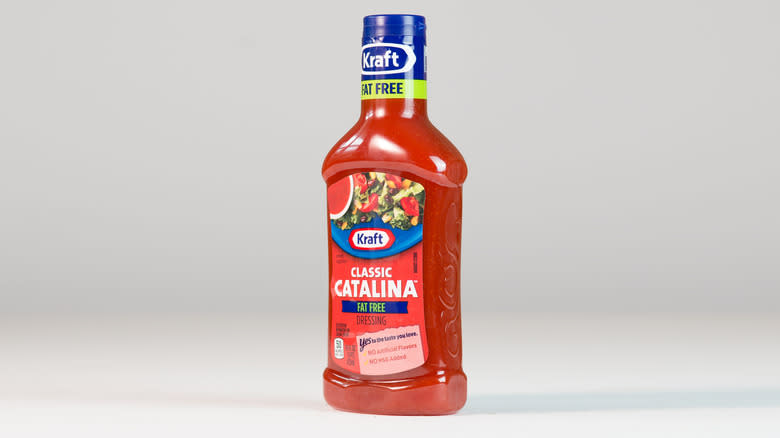
If you concluded that you should swap ranch dressing for fat-free ranch dressing to avoid the added fat and calories, we have some bad news. Fat-free salad dressings come with their issues too. For one, while they might not contain as much fat or calories, they still contain sodium and carbs, as well as undesirable ingredients.
For example, Great Value's fat-free ranch contains 12% of your daily recommended sodium per 2-tablespoon serving, and the first three ingredients are water, corn syrup, and maltodextrin. According to WebMD, too much maltodextrin in your diet can increase your risk of diabetes and high cholesterol. Kraft's fat-free Thousand Island dressing is similarly high in sodium and lists high fructose corn syrup as an ingredient, while Kraft's fat-free creamy French dressing contains 10% of your daily recommended sugar and 13% of your daily recommended sodium per serving.
Then, there's the issue that you might not be getting all the benefits from your salad that you could. A 2017 study published in the American Journal of Clinical Nutrition showed that oil and fat help you absorb nutrients. So, the next time you reach for a fat-free salad dressing thinking you're doing your body a favor, reconsider.
Teriyaki Sauce
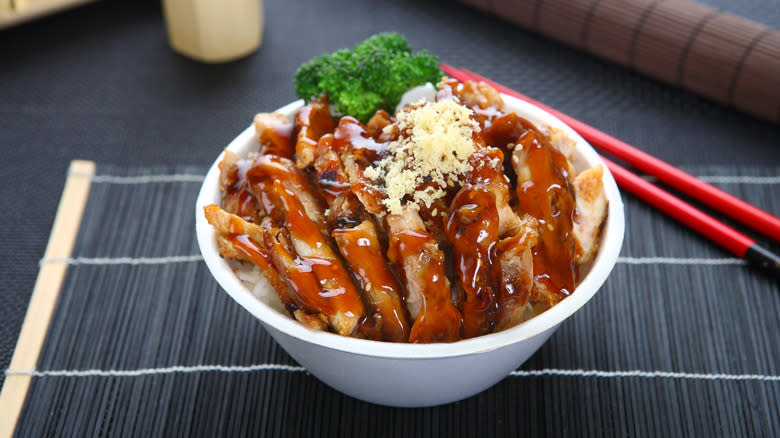
Whether you're adding it to a stir-fry, or using it as a marinade or dip, teriyaki sauce is deliciously sweet and savory. Most teriyaki sauces though, are high in sodium and sugar. One of the main ingredients in teriyaki sauce is actually another condiment on this list: soy sauce. Panda Express' teriyaki sauce contains around 500 milligrams of sodium per 2-tablespoon serving, for more than 20% of your daily recommended intake, along with 14 grams of sugar or nearly 30% of your daily recommended intake. Lawry's teriyaki sauce is much lower in sugar with 3 grams, but higher in sodium, with a tablespoon serving containing 25% of your daily recommended intake.
For a healthier option, look for a low-sodium teriyaki sauce or make your own at home using low-sodium soy sauce. You can also make teriyaki sauce using coconut aminos in place of the soy sauce. Coconut aminos is significantly lower in sodium than soy sauce and is commonly used as a substitute.
Pancake Syrup

Sure, pancake syrup may be relegated to breakfast foods, but it's still a condiment. In general, maple syrup is considered healthy in moderation since it contains many antioxidants and nutrients, making it a fairly popular white sugar replacement for many home cooks (though it still contains 53 grams of sugar per quarter-cup serving). However, not all pancake syrup is pure maple syrup, so not all pancake syrup contains these antioxidants and nutrients.
If you don't go the pure route, expect your pancake syrup to be mostly high fructose corn syrup, with no maple trees in sight, as is the case with Pearl Milling Company's syrup and Mrs. Butterworth's syrup. High fructose corn syrup is not a healthy addition to your daily morning meal. For a healthier breakfast, go with pure maple syrup in moderation, or top your pancakes and waffles with something less sugary. Try a low-sugar fruit compote, jam, fresh fruit, or nut butter.
Hoisin Sauce

Like teriyaki sauce, hoisin sauce can be used as a dipping condiment, glaze, or marinade, among other uses. It has a similarly sweet and savory flavor profile, and its primary ingredients include sugar and salt. Kikkoman's hoisin sauce contains 480 milligrams of sodium and 18 grams of sugar per 2-tablespoon serving, which is 21% and 36% of your daily recommended intake, respectively. Lee Kum Kee hoisin sauce contains 840 milligrams of sodium per serving, for a whopping 35% of your daily recommended sodium intake.
If you're following the American Heart Association's recommendations of consuming no more than 1,500 milligrams of sodium per day, 1 tablespoon of hoisin sauce could account for more than half your daily allotment. For a healthier alternative, look for similar sauces that blend sweet and salty flavor notes, or make your own. Try combining soy sauce and peanut butter, or molasses and sriracha, for example.
Queso
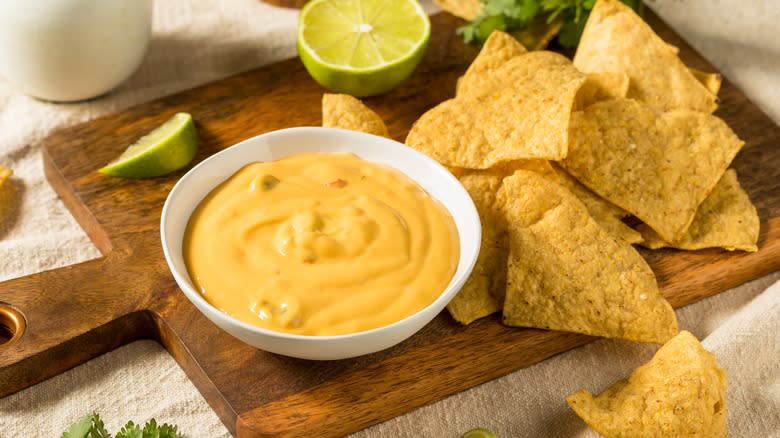
Arguably one of the best parts of going to a Mexican restaurant? The queso and chips. You could make an entire meal out of the duo. It's even tastier when you start adding queso to your other food — dip your burrito in it, pour some over your fajitas, etc. However, you may want to go easy with the store-bought queso. Depending on the brand you buy, this condiment could be high in sodium and fat. Furthermore, many brands suggest serving sizes of just 2 tablespoons — a laughable amount once you tear open a bag of chips and dig in.
Taco Bell's mild salsa con queso, available in stores, contains 7 grams of fat (9% of your daily value) and 380 milligrams of sodium (17% of your daily value) per 2-tablespoon serving. Tostitos' salsa con queso has less sodium and fat, but still a large amount of the former, with 280 milligrams per serving. For a healthier option, make your own queso at home using fresh cheese (not processed Velveeta).
Chocolate Syrup
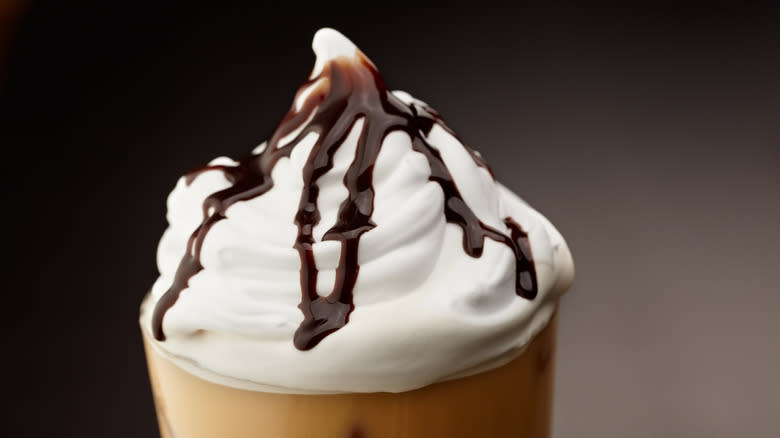
Whether you mix it into a glass of milk, drizzle it over a bowl of ice cream, or toss it with spaghetti Buddy the Elf-style, chocolate syrup just makes your favorite desserts (or pastas) a little sweeter. However, some chocolate syrups are healthier (or rather, less unhealthy) than others. The classic Hershey's syrup comes with 10 grams of added sugars per tablespoon, for about a fifth of your daily recommended intake, and the very first ingredient is high fructose corn syrup. Nesquick's chocolate syrup isn't made with high fructose corn syrup but it does have more sugar, at 12 grams per serving. Hershey's Zero Sugar chocolate syrup fixes the sugar problem, but it contains erythritol, an artificial sweetener that has been linked to an increased risk of heart attack and stroke (via WebMD).
All that considered, you're going to have a hard time finding a chocolate syrup that's not loaded with sugar and also not filled with questionable ingredients. Chocolate syrup is sugar at its core. For that reason, try to go with a chocolate syrup that contains the fewest number of ingredients possible, and only ingredients you recognize.
Duck Sauce

You may just know it as the orange sauce that comes with your takeout order, but duck sauce (sometimes called plum sauce) is a delicious dip for egg rolls and wontons. Unfortunately, it's filled with sugar and, in some cases, a fair amount of sodium, too. Ty Ling's duck sauce, for example, contains 13 grams of sugar, for 24% of your daily recommended intake per serving, along with 230 milligrams of sodium, or 10% of your daily recommended intake, all in just 2 tablespoons.
Luckily, if you're eating duck sauce from the little packets you get at your favorite takeout spot, you can easily manage your portions. However, you may want to refrain from going too hard on this condiment or consider making your own at home with just two ingredients. An easy option is to combine apricot jam and vinegar, for a tasty dipping condiment minus the large amounts of salt and sugar.
Buffalo Sauce
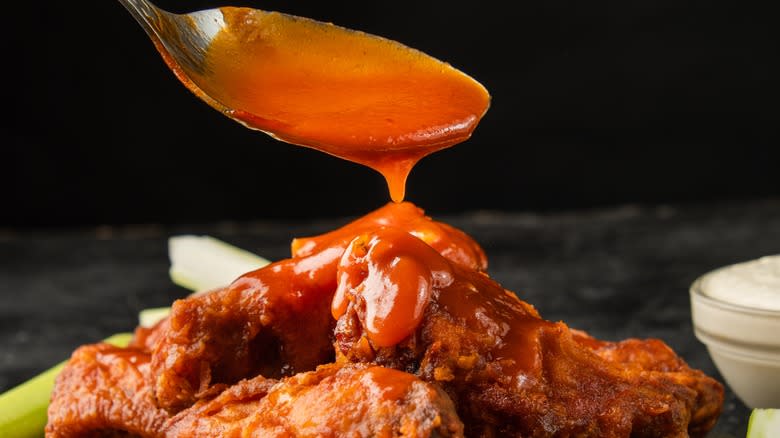
Buffalo sauce is a must-have for wings, but it's also pretty great on pizza, in dips, or anywhere you want a zippy, tangy, slightly spicy jolt of flavor. Unfortunately, while buffalo sauce may not seem overly salty, it does contain a large amount of sodium. Frank's RedHot buffalo wing sauce, for instance, contains 460 milligrams of sodium (19% of your daily recommended intake) in a single tablespoon. Buffalo Wild Wings' buffalo sauce comes with 1,070 milligrams of sodium per 2-tablespoon serving, which is nearly half your recommended daily allotment.
If you're watching your sodium intake, you probably want to steer clear of most buffalo sauces. Consider swapping traditional buffalo sauce with a straight hot sauce. Many hot sauces are generally considered healthy condiments, as most rely on peppers for their flavor and have little in the way of salt, fat, or sugar. (Tabasco, as an example, has 35 milligrams of sodium per teaspoon and just three ingredients: vinegar, red pepper, and salt.)
Steak Sauce
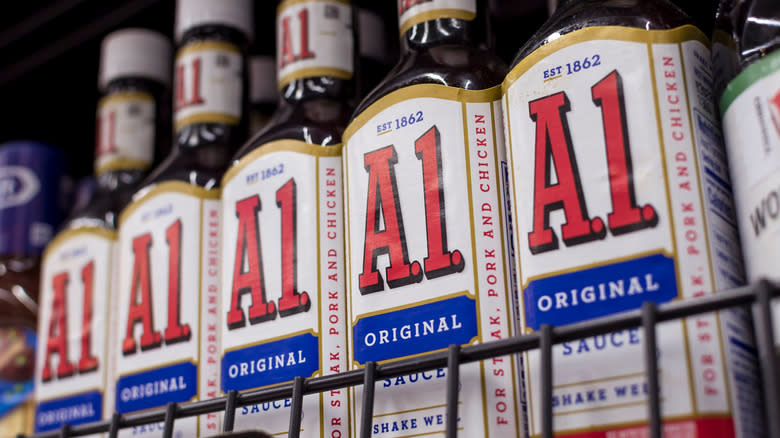
Steak sauce can be seriously unhealthy. Sugar, sodium, and fat all lurk within this non-assuming condiment, which can sometimes also contain undesirable ingredients, like high fructose corn syrup. A1 Original Steak Sauce is filled with sodium, at 290 milligrams per serving, which is 13% of your daily recommended intake. Meanwhile, A1 Thick & Hearty Steak Sauce contains high fructose corn syrup, and Omaha Steaks Traditional Steak Sauce has 11 grams of sugar per 2-tablespoon serving.
Luckily, you can find a few healthy options at the grocery store, without resorting to making your own steak sauce at home. Look for a store-bought steak sauce that contains less sodium (the U.S. Food & Drug Administration classifies a food item as "low sodium" if it contains 140 milligrams of sodium or less per serving). Additionally, look for lower-sugar steak sauces that get their sweetness from less-processed ingredients (i.e., not high fructose corn syrup).
Read the original article on Mashed.

